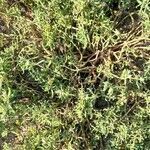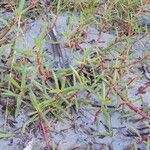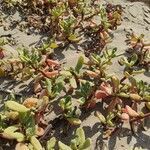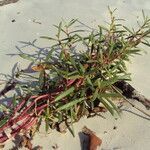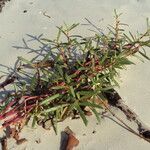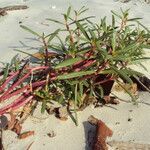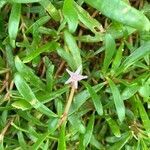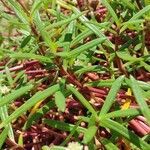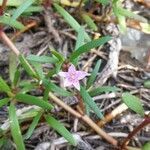Perennial herb, glabrous; stem much branched, terete, trailing up to 2 m (often less), often rooting at nodes. Petiole 1-12 mm long; blade often seemingly with salt-exuding hydathode glands above, oblong, elliptical, narrowly oblanceolate, linear-oblong or linear, 1-5(-7) x 0.2-2.5 cm, apex obtuse to acute, base clasping and often overlapping; venation indistinct. Flowers solitary, on a glabrous pedicel to 2 cm long; perianth-tube obconic to subcampanulate, 1.5-3 mm long, lobes lanceolate, ovate-lanceolate or ovate, 4-10 x 2-6 mm, thickened, outside usually prominently veined and green, appendage 1-2 mm long, inside pink, lilac or pinkish-purple, margin scarious pink or hyaline; stamens numerous (ca. 25), unequal, included, inserted at orifice of perianth-tube, filaments 1.5-5 mm long, free above, connate below in a skirt-like tube, anthers reddish, oblong, 0.5-1 x 0.25-0.5 mm; ovary ovoid to subglobose, 3-4 x 2.5-3(-4) mm, styles 3-4, linear, free except at very base. Capsule ovoid, obovoid or conical, 6-11 x 3-6 mm, circumscissile below middle; seeds 8-30, lenticular-reniform or orbicular, black, smooth, shiny, ca. 1-1.5 mm wide, aril membranous, transparent.
Perennial, prostrate or creeping herb, with a strong taproot, often much branched and densely caespitose, quite glabrous. Stems rooting from the nodes, terete, rather thick, solid, succulent, green or very often red, 20-80 cm long. Leaves mostly lanceolate, linear-lanceolate or linear, less often oblong, broadest above the middle, very succulent, flat above, convex underneath, green or, at the base, red, finely pale-punctate, 25-70 by 6-15 mm. Petioles 7-15 mm long, dilated at the base into a scarious semi-amplexicaul sheath. Flowers solitary in the leaf-axils. Pedicels thickened upwards, ½-1½ cm long, rarely longer. Perianth 8-10 mm long, 5-cleft to far below the middle. Segments with a dorsal, subapical, erect, subulate, obtuse, fleshy, ± 1½ mm long apiculus; the parts exposed in bud fleshy, green outside, overlapped margins membranous pink, inside of perianth pink. Stamens ∞, filaments free, pink or pinkish violet, shorter than the perianth-lobes, anthers darker-coloured. Ovary glabrous, 3-or sometimes 4-celled. Styles as many as cells, white. Capsule included by the perianth, oblong, 9-11 mm long. Seeds long-funicled, shin-ing black.
Suberect herb; stems to 1 m long, thick, smooth; nodes distant. Leaves linear, lanceolate or oblanceolate, connate at base, 10–70 mm long, 2–15 mm wide, smooth, fleshy, glossy green. Pedicels 3–15 mm long, thickening upwards. Perianth tube 3 mm long; lobes triangular, 6–9 mm long, with scarious margins, with a distinct fleshy dorsal mucro behind apex c. 1.5 mm long, green outside, pink to purple inside. Stamens numerous; filaments c. 6 mm long. Ovary ovoid; styles 3, c. 4 mm long; locules 3; ovules several per locule. Operculum subovoid, c. 8 mm long; smooth. Seeds several, pea-shaped to comma-shaped, c. 1.5 mm diam., smooth, black.
Herbs perennial. Stems prostrate or creeping, green or red, 20-50 cm, much branched, often rooting from nodes, with white bladder cells. Leaves linear-oblanceolate or elliptical, 1.5-5 cm × 2-10 mm, below middle attenuate, base broadened into membranous margins clasping stem. Pedicel 5-20 mm. Flowers solitary. Perigone 6-8 mm; tube ca. 2 mm; lobes 5, ovate-lanceolate, outside green, inside pink. Stamens 15-20, connate with perigone tube below middle. Ovary obovate, glabrous; stigmas 3-5. Capsule obovate, shorter than perigone. Seeds shiny black. Fl. Apr-Jul. 2n = 36, 40, ca. 48.
Plants perennial, glabrous. Stems prostrate, forming mats to 2 m diam., branched; rooting at nodes. Leaves: petiole ± absent; blade oblanceolate to elliptic-ovate, to 6 × 2.5 cm, tapered to clasping base. Inflorescences: flowers solitary; pedicel to 20 mm. Flowers: calyx lobes pink-purple adaxially, with subapical abaxial appendages, ovate to lanceolate, 3-10 mm; stamens 30; pistil 5-carpellate; ovary 5-loculed; styles 5. Capsules conic, 10 mm. Seeds 30-60, black, 1.2-1.5 mm, shiny, smooth.
A sprawling herb. This is a low lying fleshy plant. The stems are reddish at the nodes and 20 to 50 cm long with short upright branches. The stems are thick. The leaves are oblong and narrow. They can be 1-7 cm long by 2-15 mm wide. They are fleshy and glossy green. The flowers are small and pink or red. They are star like and have 5 petals. The occur singly in the axils of leaves. There are several pea shaped seeds. They are 1.5 mm across.
